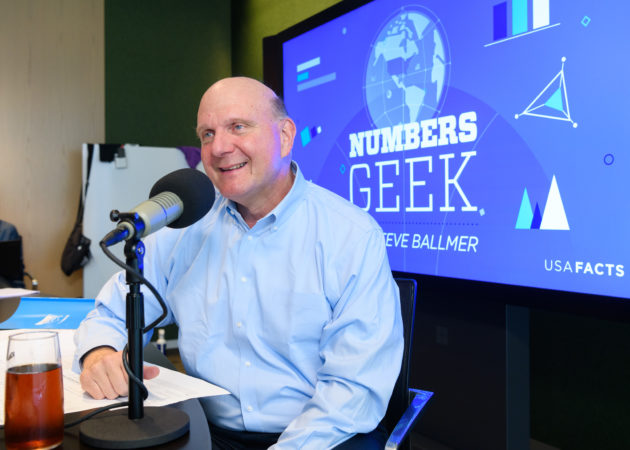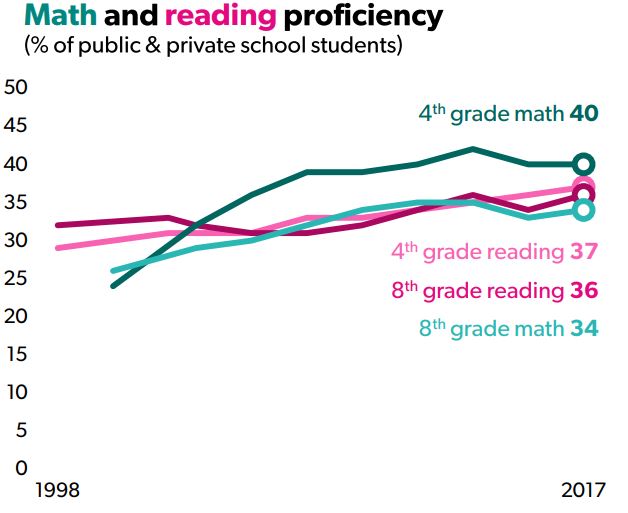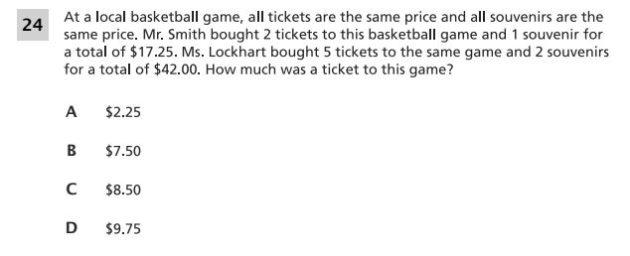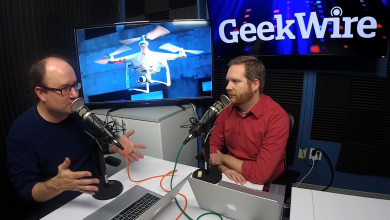The Education Equation: What the numbers say about the state of U.S. public K-12 schools

Back in ninth grade, Steve Ballmer transferred to a new school in Detroit and found himself behind in math. Fortunately, he had Ted Kuss as a math teacher.
Introducing ‘Numbers Geek,’ a new podcast from GeekWire and Steve Ballmer’s USAFacts
“Mr. Kuss decided I was a pretty good at math, and along about March or April, he said, ‘You know, you might be able to catch up and do Algebra 2 in the next three months, and then you’d be all caught up with the kids in your grade,’” he recalls. “So I said, ‘Yes, let’s do that!’”
So he caught up — and then some.
“The next year I just got carried away and I took geometry, pre-calculus and calculus all at the same time,” he says. “That was 10th grade, and then I was out of math classes at my high school, so the last two years I went to a local college, and I took math classes up there.”
Would he have gone on to graduate from Harvard with a degree in math and economics, serve as Microsoft CEO and become the owner of the L.A. Clippers, if not for Mr. Kuss?
“No,” he says. “No chance.”
His experience as a kid is a perfect illustration of the importance of teachers, and the power an effective educational system. But how effective are U.S. schools today? That’s the core question on this second episode of our new podcast, Numbers Geek, a partnership between GeekWire and USAFacts, the non-partisan, not-for-profit civic data initiative. USAFacts was founded by Steve Ballmer, who serves as our Resident Numbers Geek on the show, joining us regularly to discuss the numbers behind business, government and sports.
On this episode, we’ll explore the numbers behind education spending, student-teacher ratio, teacher pay, graduation rates and test scores in an effort to better understand the underlying dynamics of U.S. education. We’ll also test Steve’s knowledge of algebra, and offer you a chance to win your very own Numbers Geek shirt, if you can solve the problem below.

And guess who we found? Yep, we caught up with none other than Steve’s former high-school math teacher, Ted Kuss, for an enlightening conversation.
Listen to the episode above, or subscribe in your favorite podcast app, and continue reading for notes on the numbers in this show.
- Education spending: $850 billion in 2015, about 15 percent of total state, local and government spending of $5.7 trillion.
- Student-teacher ratio: 16-to-1 for U.S. public schools. (Not to be confused with class size, which was 21.2 students per class in U.S. public elementary schools, and 26.8 in high school as of the latest government report.)
- Average U.S. public teacher salary, adjusted for inflation: $58,102 as of 2015, up from $46,511 in 1980 but down from $60,759 in 2010.
- High school graduation rate, as a percentage of the 17-year-old population: 81.7 percent as of the 2012-2013 school year.
- Test scores: 8th grade reading proficiency: 36 percent; 8th grade math proficiency: 34 percent; 4th grade reading proficiency: 37 percent; 4th grade math proficiency: 40 percent. These numbers are from the National Assessment of Educational Progress, which is administered to a sampling of students in the 4th, 8th, and 12th grades.

Steve’s takeaway: “We have a lot of work to do to help our kids. The numbers don’t tell us causality, and I’m sure there’s some discussion amongst teachers as to whether these tests measure what they should, and whether teachers are teaching to tests, but at the end of the day, if we have no outcomes that we believe in and we measure, it is really hard to say how our schools are doing. So among students, teachers, parents, there needs to be some kind of concurrence on how we’re going to assess our kids. Then the system, the legislature primarily, has to come together and say, ‘Here’s what we all think will really make a difference in student achievement.’ There needs to be a theory. The theory may be different in each state, but there must be a theory and there must be a demand for improved performance.”
See page 62 of the USAFacts 2018 Annual Report for more of the numbers behind U.S. education.
Here’s the pop quiz we gave Steve, from the New York State Testing Program Grade 8 mathematics test. Can you solve it?
Send your solution to [email protected]. The first 10 people who submit the right answer will win a Numbers Geek shirt, so please include your preferred shirt size (in men’s or women’s sizes) along with your mailing address.
UPDATE, Dec. 18: Congrats to everyone who got the right answer! The ticket price is $7.50, which you can figure out using simultaneous equations. We’ve given out the allotted shirts, but be sure to subscribe to Numbers Geek, as we’ll have more contests and chances to win in the future.
Conclusion: So above is the The Education Equation: What the numbers say about the state of U.S. public K-12 schools article. Hopefully with this article you can help you in life, always follow and read our good articles on the website: Ngoinhanho101.com






